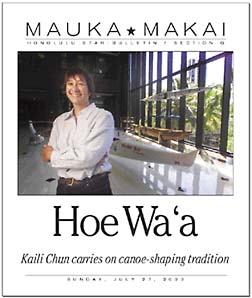
[ MAUKA MAKAI ]
RICHARD WALKER / RWALKER@STARBULLETIN.COM
"Building a canoe is a metaphor for so many things," says master woodworker Kaili Chun, who organized "Hoe Wa'a -- the Gathering of Canoes." Beside her is an old Hawaiian canoe on loan from the Outrigger Canoe Club.
Tribute to
the canoeA downtown exhibit
celebrates the art
of Polynesian watercraft
Like any useful artifact in the hands of skilled craftsmen, the Polynesian canoe grew more refined and beautiful as the years rolled by. Any functional object in daily use also has a design aesthetic that simply says if it looks right, it is right. A human's interaction with the object goes beyond simple manipulation -- it massages our inner senses of order, balance, symmetry and pure, cool sexiness.
Which is likely why the Polynesian canoes, canoe models and photographs on display in "Hoe Wa'a -- The Gathering of Canoes," in the gleaming lobby "Exhibit Space" at 1132 Bishop St. through Sept. 26, speaks eloquently not only to our eyes, but to our hearts.
Like other exhibits with a Hawaiian theme, it's underwritten by building management and curated by Koa Gallery's David Behlke. "Hoe Wa'a" grew out a brainstorming session with Behlke, the architect and building managers.
"The building is very sensitive both to the environment and the Hawaiian culture, and so our big summer exhibits try to give back to the community," said Behlke.
Kaili Chun organized the pieces on exhibit, and credits 1132 building manager Bobbie Lau for being the exhibit spark plug. "So much stuff downtown has nothing to do with Hawaii, she wanted to have a Hawaiian theme in the exhibit space every summer," said Chun. Last year's exhibit dealt with surfing longboards.
Apprenticed to master woodworker, canoe builder and Kamehameha Schools mentor Wright Bowman Sr., Chun chose works with a keen eye for their tactile and organic beauty in wood as well as their historic lines. The exhibit is dedicated to Bowman, 95, and includes a koa canoe partially carved for the Smithsonian by "Wrighto" Bowman, Bowman's late son. The sense of legacy is strong in this piece, clearly a canoe, embryonic in shape -- and incomplete in finish, a diamond in the rough.
Chun also credits historian-artist Herb Kawainui Kane's pioneering scholarship for revitalizing the craft of constructing voyaging canoes. "Mr. Kane is responsible, probably more than anyone else, for all this revival of interest in canoes," said Chun. "His paintings made them come alive, and he designed the original Hokule'a, which the Bowmans helped build."
RICHARD WALKER / RWALKER@STARBULLETIN.COM
A model of the Hawai'iloa by Wright Bowman Sr. is made of spruce and koa, above.
Unfortunately, there are no Kane paintings on display, but there are photographs by Kimo Hugho and Masako Cordray, as well as several extraordinary modern canoes, ranging from a 45-foot Sonny Kaukini Bradley Striker-type "Amelika U'iloa," to a tiny, lightweight one-man racing outrigger kayak used by paddler Mike Judd.
The kayak weighs only a few pounds. By canoe racing rules, the Striker weighs 400 pounds, and getting the massive canoe up an escalator into the lobby was a special challenge. "I learned not to be the guy at the tail end as it's going up," laughed Behlke. "Now I know what it's like to be in a trash compactor."
LIKE THE PRECISE design tolerances of an aerobatic aircraft or a Formula One racer, the design of modern canoes pays exacting attention to hydrodynamics. Chisels are needed to create canoes, but so are computers.
"That's because most canoes built these days aren't working boats -- they're designed for racing or surfing. Sport boats," said Chun.
Slightly out of the Hawaiian theme is navigator Mau Pius Piailug's own model of his Micronesian fore 'n' aft canoe, in which the mast can be moved from one end to another to reverse direction.
As a practicing -- "but still learning" -- master woodworker, Chun believes wood "has an instant attraction because it's alive. The spirit is always in the wood, as opposed to something like ... clay, which is fired and changes its character. Wood's character is always present."
Hawaii is full of fine woodworkers, Chun says, and the industry is already attracting worldwide attention. She believes the state needs to pay more attention to growing fine local woods such as ohia, milo, kou and koa.
RICHARD WALKER / RWALKER@STARBULLETIN.COM
Modern fiberglass canoes. Amelika U'iloa (Beautiful, Grand America), 45 feet long, is striped a patriotic red and white with a touch of blue. Makia, at 19 feet long, is the work of Tiger.
"Koa goes for $15 to $50 a board foot. Sandalwood is sold by the pound instead of the foot. What other type of crop brings in that kind of income?" she said. "It's well worth investing in fine wood. Our children will benefit in the long run."
And that sense of legacy is the reason she became involved in "Hoe Wa'a."
"It's a chain of experience to instill Hawaiian values," she said. "Building a canoe is a metaphor for so many things, including becoming part of a community."
"Hoe Wa'a --
Where: 1132 Bishop St.
The Gathering of Canoes"When: Exhibition on view 6:30 a.m. to 6:30 p.m. Mondays to Fridays, and 6:30 a.m. to 2 p.m. Saturdays through Sept. 26
Admission: Free
Information: 599-5009
Click for online
calendars and events.




